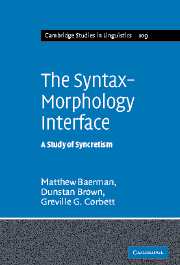Book contents
- Frontmatter
- Contents
- Preface
- List of abbreviations and symbols
- 1 Introduction
- 2 Characteristics of syncretism
- 3 Cross-linguistic typology of features
- 4 Formal representation
- 5 Formal framework and case studies
- 6 Conclusion
- Appendix 1 Case syncretism in the World Atlas of Language Structures sample
- Appendix 2 Person syncretism in the World Atlas of Language Structures sample
- Appendix 3 Syncretism in two-place verbs in the World Atlas of Language Structures corpus
- Appendix 4 DATR fragment for Dhasaanac case study
- Appendix 5 DATR fragment for Dalabon case study
- Appendix 6 DATR fragment for Russian case study
- References
- Author index
- Language index
- Subject index
4 - Formal representation
Published online by Cambridge University Press: 22 September 2009
- Frontmatter
- Contents
- Preface
- List of abbreviations and symbols
- 1 Introduction
- 2 Characteristics of syncretism
- 3 Cross-linguistic typology of features
- 4 Formal representation
- 5 Formal framework and case studies
- 6 Conclusion
- Appendix 1 Case syncretism in the World Atlas of Language Structures sample
- Appendix 2 Person syncretism in the World Atlas of Language Structures sample
- Appendix 3 Syncretism in two-place verbs in the World Atlas of Language Structures corpus
- Appendix 4 DATR fragment for Dhasaanac case study
- Appendix 5 DATR fragment for Dalabon case study
- Appendix 6 DATR fragment for Russian case study
- References
- Author index
- Language index
- Subject index
Summary
Introduction
It is a generally shared assumption that any adequate formal model of morphology ought to take some account of inflectional syncretism. Most investigators who have addressed syncretism overtly have taken this assumption one step further: it is not enough to describe syncretism, one should also constrain it. This goal is motivated by two factors. First, syncretism is something of an aberration: by default we assume a one-to-one relationship between morphosyntactic function and form, and syncretism is a violation of this assumption (Carstairs 1987). Second, syncretism displays preferred patterns, as we have seen throughout Chapter 3.
Ultimately, the morphological description of a particular syncretism must contain two elements: (i) a list of the set of values which are syncretic, and (ii) a way of associating this set with a form. To a large extent, constraints on syncretism are a product of how these elements are treated. For example, the syncretic set may be a natural class of values or simply a stipulated disjunction, while the form itself may be defined over the whole set, or defined in terms of one of the constituent members. In §4.2 below we examine the inherent properties of different rule types, and in §4.3 we see how these have been employed in particular accounts of syncretism.
Defining sets of values
Natural classes
Probably the most common approach to syncretic sets of values is to treat them as a reflection of underlying feature structure.
- Type
- Chapter
- Information
- The Syntax-Morphology InterfaceA Study of Syncretism, pp. 126 - 170Publisher: Cambridge University PressPrint publication year: 2005



